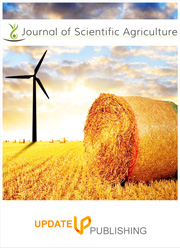Comparative study on fruit development of four cultivars of Mango (Mangifera indica L.) in River Nile State, Sudan
DOI:
https://doi.org/10.25081/jsa.2025.v9.9156Keywords:
Pomegranate, Punice granatum, IBA, NAA, Cuttings, NileAbstract
An experiment was carried out to investigate mango (Mangifera indica L.) fruit development by recording the rate of increase of fruit size and fruit characteristics during the season (2017-2018) of the study. The experiment was conducted in a randomized complete design. Four cultivars (Kitchener, Alphonse, Mabroka and Naylum) were used in the investigation. From each cultivar three trees were selected. Seventy two fruits were labelled. Each one was measured every 2 weeks and for ten consecutive weeks. This was done to determine the rate of fruit development under the prevailing conditions. The results of the experiment showed that the highest values of development of mango fruits and the highest mean of fruit size occurred during the period of development of the fruits from the second week through the tenth week. The results showed that there was a significant increase in the size of the fruit during the first four weeks and a non-significant increase in the following weeks. This is in addition to the physical analysis which included dimensions and weights of fruits during the different stages of maturity. The results showed that there was superposition and difference between the four cultivars during different maturity stages. The Naylum cultivar gave the highest length or longest fruits at the full ripe stage, whereas the shortest fruit exhibited by the Alphonse cultivar at the full ripe stage. The Naylum cultivar gave the highest width at the green stage, where the shortest width was given by the Kitchener cultivar at the full ripe stage, the Naylum cultivar gave the highest weight at the full ripe stage where the shortest weight was given by the Kitchener cultivar at the green stage. The results showed that there was superposition between Kitchener and Alphonse cultivars at the semi ripe stage.
Downloads
References
Badreldin, E. M. (2014). Mango research interventions for the successful postharvest value chains in Sudan.
Elsadig, E. H., & Suleiman, A. S. (2013). Development of Lime fruit (Citrus aurantifolia) in Northern Gezira State, Sudan. Journal of Agriculture and Biodiversity Research, 2(3), 73-79.
Gillaspy, G., Ben-David, H., & Gruissem, W. (1993). Fruits: A Developmental Perspective. The Plant Cell, 5(10), 1439-1451. https://doi.org/10.1105/tpc.5.10.1439
Kostermans, A. J. H. G., & Bompard, J. M. (1993). The Mangoes: Their Botany, Nomenclature, Horticulture and Utilization. New York, US: Academic Press.
Morton, J. F. (1987). Mango. In J. F. Morton (Eds.), Fruits of warm climates (pp. 221-239) Miami, Florida: Florida Flair Books.
Rayan, K. M. (2016). Physical and Chemical Characteristics of Three Mango Cultivars at Three Maturity Stages. M. Sc. Thesis, Sudan University of Science and Technology.
Shafique, M. Z., Ibrahim, M., Helali, M. O. H., & Biswas S. K. (2006). Studies on the Physiological and Biochemical Composition of Different Mango Cultivars at Various Maturity Levels. Bangladesh Journal of Scientific and Industrial Research, 41(1), 101-108. https://doi.org/10.3329/bjsir.v41i1.279
Siddig, R. A., Osman, M. S., Goj, A. M., Elfatih, A., & Elsiddig, M. (2016). Physico-Chemical Characteristics of Three Mango (Manifera indica L.) Cultivars in Central Sudan. International Journal of Scientific and Research Publications, 6(12), 447-451.
Sohad, A. H. (2019). Physicochemical Changes during Growth and Development of Guava (Psidium guajava L.) fruits. M. Sc. Thesis, University of Khartoum.
Published
How to Cite
Issue
Section
Copyright (c) 2025 Manal Abdelrahim, Elsadig Hassan Elsadig

This work is licensed under a Creative Commons Attribution-NonCommercial-NoDerivatives 4.0 International License.



 .
.